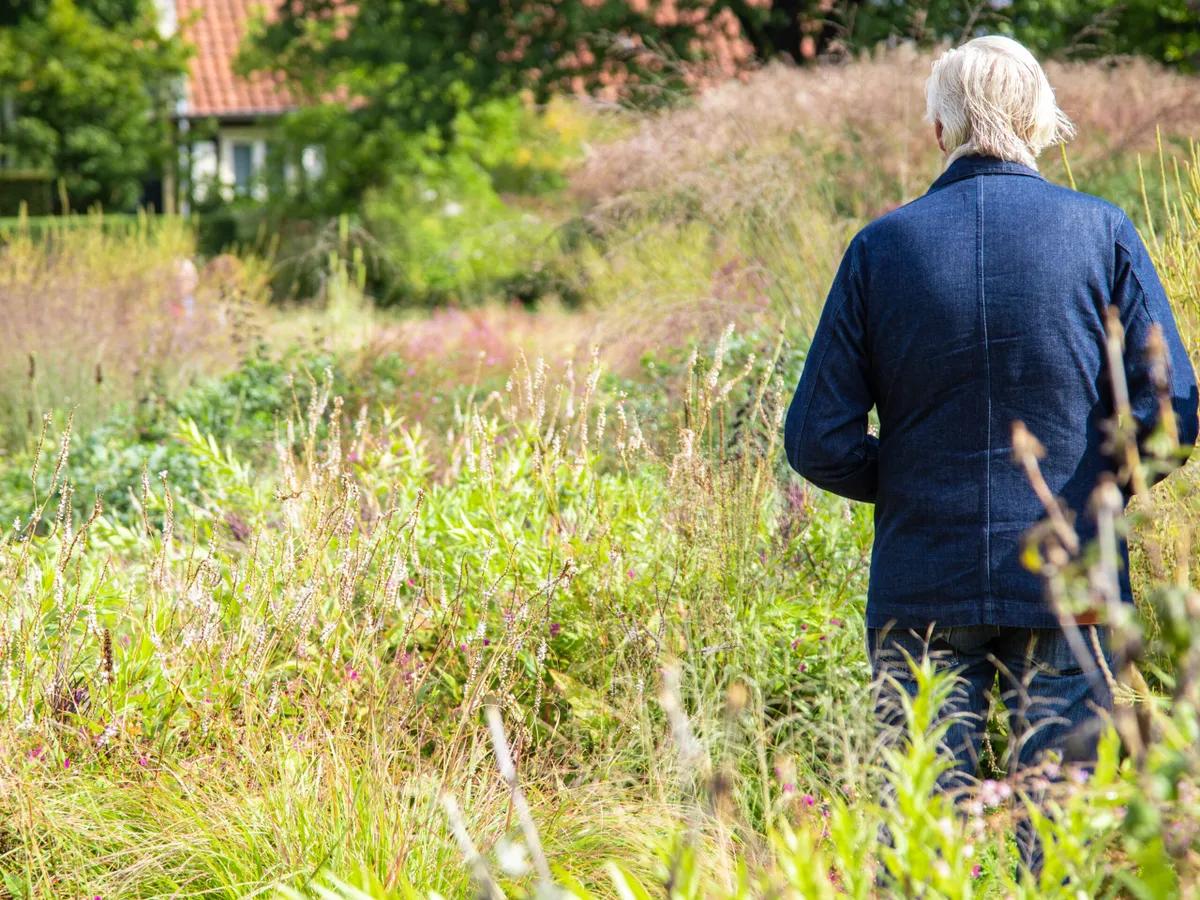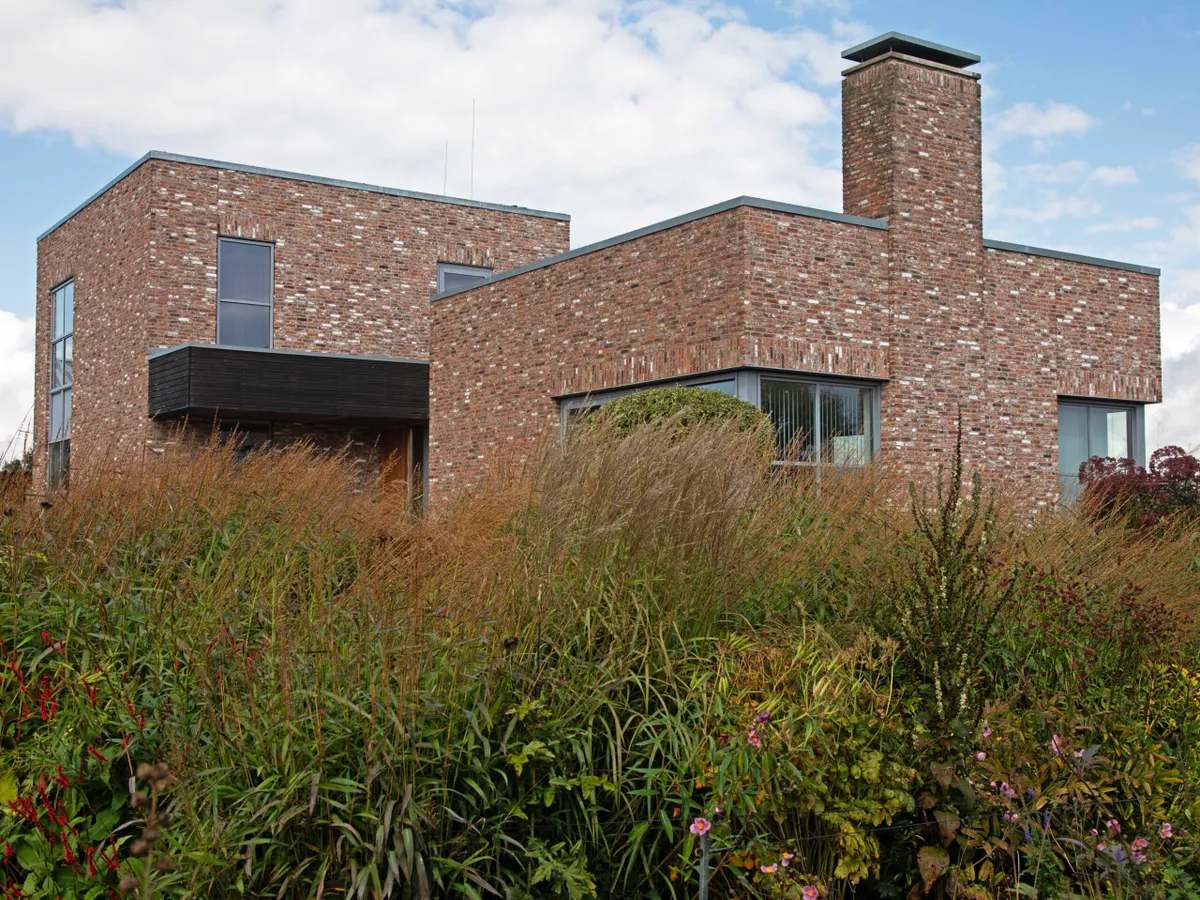Piet Oudolf is the closest thing there is to a horticultural superstar - the Beyoncé, if you will, of gardens. The Dutch designer - instantly recognisable for his tall frame and flop of white hair - recently turned 79, and spoke about his illustrious career on the Talking Gardens podcast. You might assume that his unique level of success is the result of coming from a long line of gardeners or horticultural royalty, but Piet is in fact an outlier who had to learn everything from scratch.
Listen to the Talking Gardens podcast with Piet Oudolf
He was in his twenties, working in his parents’ restaurant, and unhappy, when he decided to find a different career, and tried out various jobs in a fishery, a steel factory and a garden centre. It was there that he became interested in gardening, and began to buy plants. “Within a year I was addicted,” he says. “I wanted to know everything. So I went back to school in the evening for four years, and studied to get qualifications so I could start my own business building gardens.”

After several years as a contractor, and frustrated at not being able to source the plants he wanted for his projects, Piet looked for somewhere he could grow them himself. “That was how we found this place, a derelict farmhouse in Hummelo,” he explains. He started his nursery in 1982 with horticulturist Romke van de Kaa, who had worked at RHS Wisley and also Great Dixter under Christopher Lloyd, and designing gardens took a backseat as the pair looked for interesting plants to grow. “In the beginning, it was an adventure,” Oudolf says. “Everywhere we went, we found new plants. We also collected seed from botanical gardens and grew them here to test them out.”
"A garden is not a painting, but a performance in time. I put plants on a stage and let them perform. You can’t control the planting, just conduct it."
Piet Oudolf
Eventually they dissolved their partnership and went their separate ways, but in those years Piet met and formed relationships with many of the greats of the British gardening scene, including Beth Chatto and John Coke, who gave him his first big garden commission in the UK, at Bury Court in Surrey.
You may also like
- Discover the Oudolf Field at Hauser & Wirth
- 24 key plants from the Oudolf Field
- Essays by those who have worked with the Dutch master
- Piet Oudolf's plant list design from Museum Voorlinden
It was the 1990s, and his developing style, a driver of what we now call the Dutch Wave or New Perennials Movement, was about to take the gardening world by storm. However, using prairie-style perennials and ornamental grasses and leaving everything up over winter all seemed so contrary to the norm of annual bedding and mixed borders, cottage garden plants and conifers. “Nobody understood how a nurseryman from the Netherlands could make a garden like this,” he says. “They found it strange. But the British were the first people to appreciate my work, this new way to garden. You wouldn’t think it, because traditional English gardening is so dogmatic, but the acceptance was quite quick.”
His first book, Dream Plants for the Natural Garden, with plantsman Henk Gerritsen, shared their ethos, and he has gone on to produce many more books with writer Noel Kingsbury. Since those early days, the New Perennials Movement has evolved into the drifts and swathes of the Naturalistic Planting style, but the central tenet of both – hard-working perennials that die well – has been instrumental in transforming countless gardens and public schemes around the world over the past 25 years.

Over the years, Piet has created ever more impressive projects, from early gardens at RHS Wisley (which he is now redesigning) and Scampston Hall to Trentham and Pensthorpe, as well as many private gardens, a Chelsea show garden for Gardens Illustrated which won Best in Show, and a Serpentine Pavilion installation. More recently, he designed plantings for the Olympic Park in London, and created the Oudolf Field at Hauser & Wirth in Somerset, and has been involved in many parks across Europe and America, including the Lurie Garden in Chicago, a garden at Noma in Copenhagen and planting for the Vitra campus in Germany.
"People want more green now, and they accept more wildness, as long as it is still aesthetic. If planting is really wow, people won’t throw their rubbish in it."
Piet Oudolf
But his most famous work, and the one which propelled him to prominence outside of horticultural circles, is the planting of the High Line, a 1.5-mile-long park elevated along a disused railway line in New York. As he became widely known, the demand for his services grew. His wife Anja ran the nursery, leaving Piet free to make gardens. The number of visitors to Hummelo increased exponentially, and the couple made the decision to close the nursery and then their garden some years ago.

The old stock and trial beds may be gone, but the spaces around the buildings are still living experiments where Oudolf tries out plants, and in his studio – an imposing modern structure at one end of the garden – he continues to develop ideas, for gardens and parks as far flung as Korea and Detroit. The clean white room is sparsely but succinctly furnished, with a drafting table in one corner and computer in the other. On shelves around the room, hard hats rub up against vinyl figurines by street artists, and sun-bleached plant books sit alongside rows of classical music CDs. In the centre is a large table with various pots and containers of coloured markers, pencils and felt-tip pens, where Oudolf sketches out his planting plans, and can look out to the garden and surrounding farmland through floor-to-ceiling windows.

The designer says he doesn’t have a philosophy, as such, but his aim is simply to share his passion with people by creating spaces that evoke pleasure. “Good gardens take you away,” he says. “They are very emotional.” This response is something he seeks out and experiences himself regularly, in both accidental and curated landscapes. In the documentary Five Seasons, of which Piet is the subject, we see him pulling over the car while on a road trip in America, captivated by the spring wildflowers on the verge. “You load yourself up with beauty, and you use it in your work,” he says. Elsewhere in the film, he visits a prairie restoration project. “I have been trying to recreate this feeling all my life,” he says, rapt, in his own understated way, by what he sees.

Piet is not, however, trying to replicate these places in his work – only the reactions they provoke, by translating that magical atmosphere into human-scale spaces. “We don’t create nature; we create gardens,” he says. “It may look wild, but it shouldn’t be wild. It has to be attractive to people – it is all about aesthetics.” He is often called an artist, but though plants are his medium, Piet feels that “a garden is not a painting, but a performance in time. I put plants on a stage and let them perform. You can’t control the planting, just conduct it.”
Whatever the location or size, all of his schemes begin with a palette of plants, based on the project site and brief, with a view to extending the interest across the seasons. Limiting this selection is, he says, the most difficult part of his work. “With perennials, you have to know so many factors – it makes planting design complicated. Is the plant aggressive or not? Short or long lived? Shade or sun? Does it have structure? How long does it flower? Are the seedheads important? A good plant is a plant that performs over a longer period than just the flowering period. It needs to have character, and perform from the moment it comes out of the ground, so with the leaf, then the flower and how it dies down or goes dormant in a beautiful way. Then, you have to be strategic in where you put your plants, so it looks good at the end. It’s all about balance, rhythm and repetition – it’s very complex.”

He believes a deep knowledge of plants is the basis of his success, and recommends that gardeners should invest time in learning about them. “Plants will disappoint you if you don’t know them. It takes years to understand plants and how to use them. They are like human beings – you might meet one and at first think, ‘Oh, they’re pretty’, but then you get to know them, and discover that maybe they are not so pretty to work with, or live with, or they might not work well with others. To know plants takes a lifetime, and you must practice using them and make lots of mistakes, because failure is part of the whole experience.”
But the future looks bright, he says, especially for public projects. “People want more green now, and they accept more wildness, as long as it is still aesthetic. If planting is really wow, people won’t throw their rubbish in it.” It is these public projects, he admits, that he enjoys the most. “It’s the sharing factor,” he explains. “So many people can see and enjoy your work and be inspired. Most people in cities don’t have gardens and would have to go outside the city to see green spaces. If done right, dynamic public gardens provide a lot of wellbeing for people. You can create a new landscape that wouldn’t normally exist and that makes people happy – an environment that is beautiful and works on the soul.”
